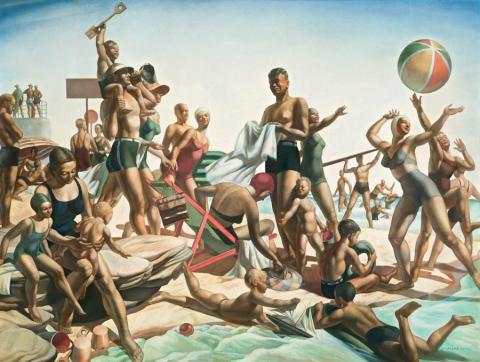AUSTRALIAN BEACH PATTERN, c.1940
Studio Of Charles Meere
oil on canvas
65.0 x 85.5 cm
signed lower right: CHARLES MEERE
Private collection, Austria
Private collection, Sydney
Australian Beach Pattern, 1940, oil on canvas, 91.5 x 122.0 cm, signed and dated lower right: 'Charles Meere 1940', Art Gallery of New South Wales collection, purchased 1965
The Beach, 1939, working cartoon, pencil on paper, 92.0 x 112.0 cm, Art Gallery of New South Wales collection
Australian Beach Pattern, 1940, oil on canvas, 75.0 x 98.0 cm, signed lower right: 'Charles Meere', Deutscher Fine Art, Melbourne, 1997, formerly private collection, Austria.
Australian Beach Pattern, oil and wax on cardboard, 73.0 x 102.5 cm, unsigned, Sotheby's, Sydney, August 1999, lot 39, formerly private collection, Austria
Australian Beach Pattern, oil on canvas, 65.0 x 88.0 cm, signed lower right: 'CM Melbourne', Deutscher~Menzies, Sydney, 4 March 2003, lot 29
Australian Beach Pattern is a true icon of Australian art in the great tradition of Tom Roberts' Shearing the Rams, 1888-90, Sidney Nolan's Ned Kelly of 1946, and Russell Drysdale's The Cricketers, 1948. Interest in the beach, swimming and surfing goes back to colonial times, with watercolours by Joseph Lycett of Aborigines on the coast. The might of the ocean was a focus for Eugene von Guerard at times, and Arthur Streeton delighted in Coogee, portraying the growing attraction of the beach as a place of physical and fashionable relaxation.
In Charles Conder's famous A Holiday at Mentone, 1888, he set the tone for the future and others followed suit, none better than Charles Meere in his Australian Beach Pattern, 1939-40. It was so popular that he was obliged to produce a number of versions (detailed under 'Related Works').
Meere took Conder's painting as a starting point, and gave it the fashionable, mural monumentality of his own time, carefully composed and idealised. English-born, Meere trained as a muralist, and his craftsman-like construction is present in all the versions. He revived the apprenticeship system in his studio, where students learned their skills while working alongside their master. Meere had three apprentices, including Freda Robertshaw, who worked mostly on poster commissions, but also on big studio pictures, such as this. Robertshaw confirmed these traditional academic techniques in Meere's workshop, noting
'Charles never went to the beach. We made up most of the figures, occasionally using one of Charles's employees as a model for the hands and feet, but never the complete figure. They were then arranged to fill in a composition until a small sketch was realised and colour indicated. It was then squared up and enlarged to the size of the painting. The outline was overlaid, pricked and then dusted with chalk. He started with a sepia base to fix the outline and then blocked in the larger areas, working slowly for about a year to complete the painting.'1
Like Conder, he presents a moment of relaxed pleasure in the sun. The centrepiece in both is a woman seated in a folding chair, the stylish red hat of the former replaced by the modish red bathing cap of the latter. And again, Meere echoes Conder in the introduction, at the far left, of the Bondi baths in response to the Mentone baths in the former's painting.
Presented like a neo-Classical frieze across the picture plane, Meere expresses the new ideal of sun-blessed freedom, unsullied by the political pollutions of Europe. Peopled by noble Anzacs, healthy, tall and upright, perfect in physique, mind and manners, Australia is the Antipodean ideal, the land of the free.
1. Slutzkin, L., 'Charles Meere 1890 - 1961', introductory catalogue essay to the exhibition of the same name, S.H. Irvin Gallery, Sydney, 1987, pp. 6-7, from an interview with Freda Robertshaw, 6 September, 1987
DAVID THOMAS
